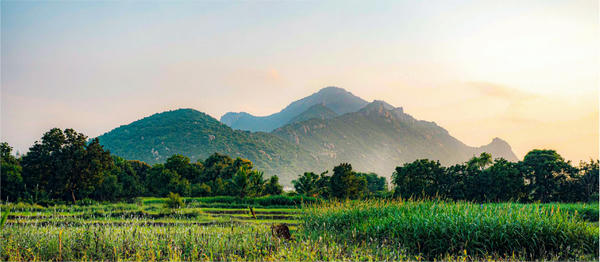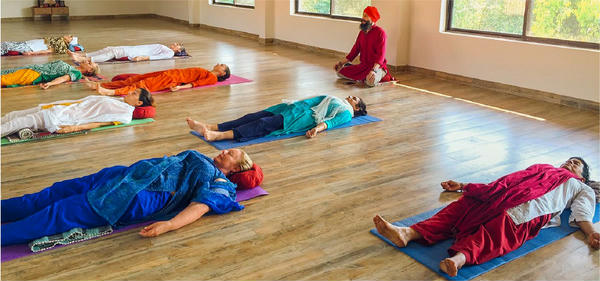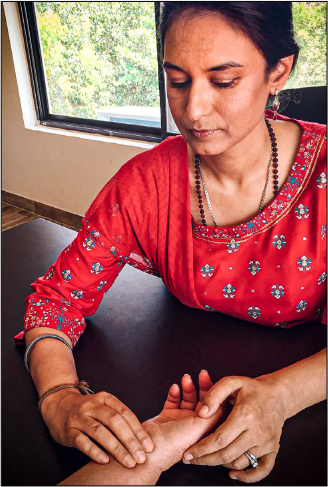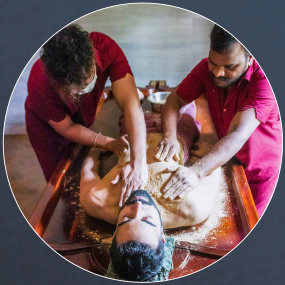Ayurveda§
India’s Age-Old Healing Science§
“The doctor of the future will give no medicine, but will interest his patients in the care of the
human frame, in diet and in the cause and prevention of disease.” —THOMAS EDISON§
 VERYBODY TALKS ABOUT THE GENES THAT THEY RECEIVED FROM their mother and father for this trait or the other, but in reality, those genes alone have very little impact on life outcomes. Our biology is way too complicated for that and deals with hundreds of thousands of independent factors. “Genes are absolutely not our fate,” remarked pioneer genomic researcher Craig Venter, known for leading the first draft sequence of the human genome in 2000 with the National Institutes of Health (NIH). “They can give us useful information about the increased risk of a disease, but in most cases they will not determine the actual cause of the disease, or the actual incidence of somebody getting it. Most biology will come from the complex interaction of all the proteins and cells working with environmental factors, not driven directly by the genetic code.”§
VERYBODY TALKS ABOUT THE GENES THAT THEY RECEIVED FROM their mother and father for this trait or the other, but in reality, those genes alone have very little impact on life outcomes. Our biology is way too complicated for that and deals with hundreds of thousands of independent factors. “Genes are absolutely not our fate,” remarked pioneer genomic researcher Craig Venter, known for leading the first draft sequence of the human genome in 2000 with the National Institutes of Health (NIH). “They can give us useful information about the increased risk of a disease, but in most cases they will not determine the actual cause of the disease, or the actual incidence of somebody getting it. Most biology will come from the complex interaction of all the proteins and cells working with environmental factors, not driven directly by the genetic code.”§
It was a forward-thinking speech, a visionary approach to the human genome and our future health, and yet it unwittingly recalled the ancient Eastern traditions—ayurvedic medicine among them—that similarly maintain that we are in constant genetic communication with our environment. Although epigenetics focuses on the physical body—specifically the way our genes are turned on and off when altered by external circumstances—Eastern medical philosophy considers the subtle energy body as well, maintaining that it, too, has a profound effect on DNA expression and, by extension, our health. The two branches of knowledge have remarkably analogous views on the effects of lifestyle on genetic expression and, subsequently, cellular modification.§
Both Eastern and Western traditions, for example, indicate that genetic inheritance is far-reaching in that a trauma suffered by one’s ancestors might still play out down the line, affecting not only an individual’s children but also their children’s children and future generations from there. What modern science now calls an “epigenetic imprint” was known as “ancestral karma” in Vedic medicine.§
In fact, when experienced ayurvedic practitioners take the pulse of their patients, we can often glean the traumas from generations past. I once had a patient—I’ll call her Emma—while running my neurology practice in San Diego. She was battling severe digestive issues. Though she had been suffering since childhood and had tried a variety of Western treatments and medicines in addition to natural therapies throughout her life, she was still unable to hold down her food much of the time. She frequently either vomited or suffered diarrhea after eating a meal. Emma was in her late fifties, with a regal presence that shone through despite her being hunched and emaciated due to her disorder. At five foot seven, she was barely ninety pounds. As soon as I felt Emma’s pulse, a picture of starving people came into my mind with another flash of a young boy indicating to me that the memory of whatever this was still persisted in her DNA. “Which generation in your family went through a famine?” I asked.§
South Indian clinic: (clockwise from right) Author Dr. Kulreet Chaudhary examines a patient’s pulse, a key tool in determining the vitality of organs and systems; meditation and hatha yoga are essential to the ayurvedic approach to regaining balance in body and mind; the Sri Narayani Holistic Centre, which Dr. Kulreet heads, is located in the pristine plains of South India.§
She blinked a couple of times and then said that a distant relative on her father’s side—she believed it was her great-great-great-grandfather—had lived in southern Ireland during the Great Famine, between the years of 1845 to 1849, during which a million people died, the greatest loss of life in nineteenth-century Europe. Many others, including Emma’s great grandfather, emigrated. From that generation onward, the family, including Emma’s mother and grandmother, had suffered what they considered to be hereditary digestive issues.§
Interestingly and coincidentally, given Emma’s situation, the most significant studies of trans-generational transmission of trauma were based on the Dutch Famine, known to those in German-occupied Netherlands as the Hongerwinter, which occurred near the end of World War II when a German blockade cut off food and fuel shipments from farm towns to the northern parts of the country. More than twenty thousand men, women and children died. Millions of others suffered but survived. Among this population were pregnant women whose children, as studies in the 1980s showed, later grew up to have high rates of obesity, diabetes and mental illness. By the time this group reached old age, the risks increased, according to L. H. Lumey, an epidemiologist at Columbia University: the Hunger Winter cohort (as those who were in utero during the Dutch Famine are referred to by researchers) died at a higher rate than people before or afterward. “We found a ten percent increase in mortality after 68 years,” said Dr. Lumey, who, along with his colleagues, reviewed the death records of hundreds of thousands of Dutch people born in the mid-1940s. Furthermore, when the grandchildren of men and women exposed to the famine were studied, they, too, were reported to have had higher rates of illness.§
In my work with Emma, I prescribed herbs and mantra meditation, but I also asked that she address and connect with her ancestral history in a way that I felt would release that trauma from her body. She was dubious, but also determined to wrestle her life back from this mysterious illness. I started by having Emma chant a bija mantra as well as work with a Reiki practitioner to help her make the connection between her digestive issues and the fear and loss that her great-grandfather experienced during the Dutch Famine. She knew a bit of his story from family lore—that he had large, pale blue eyes, that he’d seemed a fairly nervous person but very kind, too—and so she was able to bring some detail to her imagined sense of her great-grandfather. In doing this, she began to feel a kind of kinship with him when she thought about him in her mantra meditations.§
In India, in order to address ancestral karma, people perform special ceremonies such as the puja ceremony, a spiritual ritual often used to honor someone after they die. (The Sanskrit word puja means reverence, homage, adoration, worship.) Sometimes, too, Indian families make an offering on their ancestors’ behalf, such as giving a cow to a poor family. In fact, every year Hindus spend fifteen days in a period of ancestor worship called Pitru Paksha devoted to the remembrance of ancestors, during which they donate food to the hungry and reflect on the contributions of their forefathers. In ayurvedic medicine, by doing a positive thing and creating good karma, the idea is that you release some of the negative or troubled karma that has been passed down. In Emma’s case, I asked that she do something equivalent to honor her family, such as making donations to food banks on behalf of her great-grandfather.§
The notion that doing good can have meaningful health outcomes was evidenced by a remarkable 2013 study published in the Proceedings of the National Academy of Sciences of the United States of America, wherein a team of professors from the University of North Carolina at Chapel Hill and the University of California, Los Angeles, showed that acts of genuine goodness can have measurable impacts on our genetic expression and health outcomes. According to their research, the human body is able to perceive when the pursuit of wellbeing is aimed at a noble purpose and when it is being sought for simple self-gratification. They found that different gene regulatory programs are engaged for each. When a more “positive affective experience” (i.e., a noble purpose) is the goal, there is a down-regulation of the CTRA gene profile, associated with cardiovascular, neurodegenerative and neoplastic diseases, which are conditions that cause tumor growths.§
Emma had been living for so long as if she, too, were in a famine, that it took us nearly two years to shift her cellular memory and mind toward a healthier track. But, little by little, with Emma’s unyielding determination and her willingness to try things that, at first glance, seemed to have little to do with her digestion, her so-called genetic disorder did resolve itself. When we finished working together, Emma was up to 125 pounds and her body was able to metabolize food normally. It was, from my perspective, quite a beautiful transformation. I was so pleased, of course, that Emma was feeling better, and looking so healthy, but I also enjoyed watching her psychological growth as she unburdened herself of such long-held subconscious anguish.§
Divine healings: (right) Dhanvantari, the Deity of ayurveda, holds a pot of herbs, nature’s medicines, in a traditional Kerala- style artwork by Saji; (below) two trained attendants apply herbs to the body of a patient, part of a multi-day regimen of health§
Vata Dosha§
 PERSON WITH PREDOMINANT VATA TENDS TO BE SLIGHT and fine-boned; Audrey Hepburn was a good example of this type. Vata represents movement for all bodily processes; its characteristics are dry, light, quick, cold, rough, subtle, mobile and clear. On a seasonal basis, vata is at its peak in the fall, when it is generally windy and dry, and at the change of each season. Vata types are always in motion—they are alert and tend to walk and talk fast. They grasp concepts quickly but also forget them just as quickly; and they are flexible in their ideas and creativity. As such, one of the basic principles for this dosha is to create regularity in the daily routine to help ground the moving energy.§
PERSON WITH PREDOMINANT VATA TENDS TO BE SLIGHT and fine-boned; Audrey Hepburn was a good example of this type. Vata represents movement for all bodily processes; its characteristics are dry, light, quick, cold, rough, subtle, mobile and clear. On a seasonal basis, vata is at its peak in the fall, when it is generally windy and dry, and at the change of each season. Vata types are always in motion—they are alert and tend to walk and talk fast. They grasp concepts quickly but also forget them just as quickly; and they are flexible in their ideas and creativity. As such, one of the basic principles for this dosha is to create regularity in the daily routine to help ground the moving energy.§
In the body, vata resides in the colon, brain, ears, bones, joints, skin and thighs. Vata people tend to be more susceptible to diseases involving the principle of air—such as emphysema and pneumonia—as well as arthritis, gas, dry skin and hair, neurological conditions, constipation and mental confusion.§
When out of balance, vata individuals can feel unstable in the midst of change; they also become fearful, nervous and anxious. Given their wiry energy, vata types fatigue easily and often need a lot of sleep.§
The bija mantras prescribed to help bring vata back into balance are those that help calm the hyperactive qualities of this dosha. The first is Hrim (pronounced hreem), which is a specific mantra for the heart, emphasizing the physical health of the heart but also creativity and compassion. The second is Klim (pronounced kleem), which promotes blood flow and digestion as well as smooth skin. It can also help calm the brain and boost the reproductive and immune systems.§






